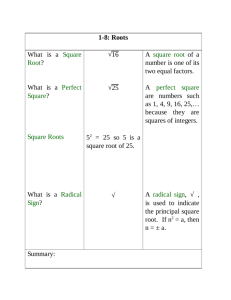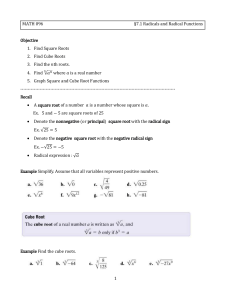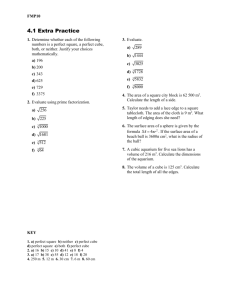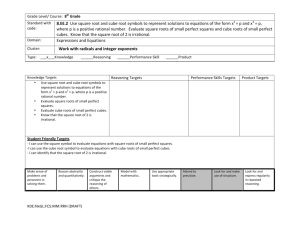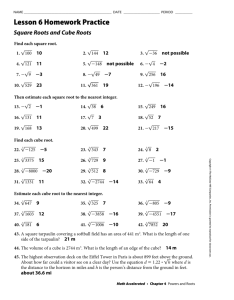Section 0.2 - BobPrior.com
advertisement
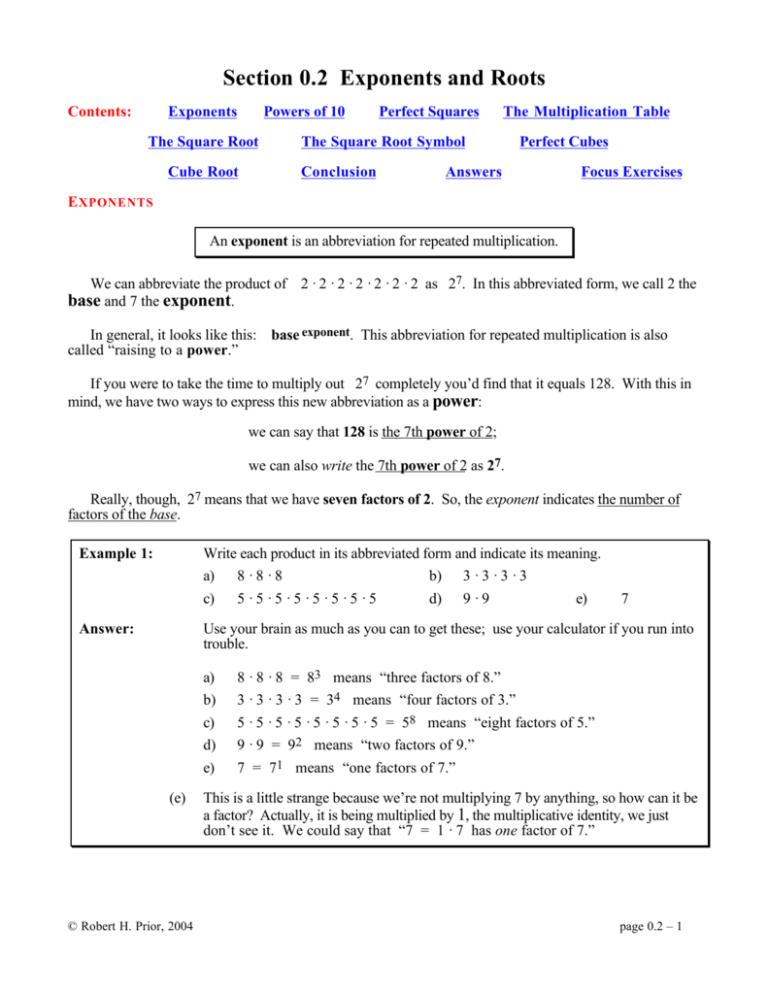
Section 0.2 Exponents and Roots Contents: Exponents Powers of 10 The Square Root Cube Root Perfect Squares The Multiplication Table The Square Root Symbol Conclusion Perfect Cubes Answers Focus Exercises E XPONENTS An exponent is an abbreviation for repeated multiplication. We can abbreviate the product of 2 · 2 · 2 · 2 · 2 · 2 · 2 as 27. In this abbreviated form, we call 2 the base and 7 the exponent. In general, it looks like this: base exponent. This abbreviation for repeated multiplication is also called “raising to a power.” If you were to take the time to multiply out 27 completely you’d find that it equals 128. With this in mind, we have two ways to express this new abbreviation as a power: we can say that 128 is the 7th power of 2; we can also write the 7th power of 2 as 27. Really, though, 27 means that we have seven factors of 2. So, the exponent indicates the number of factors of the base. Example 1: Write each product in its abbreviated form and indicate its meaning. a) 8 · 8 · 8 b) 3 · 3 · 3 · 3 c) 5 · 5 · 5 · 5 · 5 · 5 · 5 · 5 d) 9 · 9 e) Answer: 7 Use your brain as much as you can to get these; use your calculator if you run into trouble. a) b) c) d) e) (e) © Robert H. Prior, 2004 8 · 8 · 8 = 83 means “three factors of 8.” 3 · 3 · 3 · 3 = 34 means “four factors of 3.” 5 · 5 · 5 · 5 · 5 · 5 · 5 · 5 = 58 means “eight factors of 5.” 9 · 9 = 92 means “two factors of 9.” 7 = 71 means “one factors of 7.” This is a little strange because we’re not multiplying 7 by anything, so how can it be a factor? Actually, it is being multiplied by 1, the multiplicative identity, we just don’t see it. We could say that “7 = 1 · 7 has one factor of 7.” page 0.2 – 1 Elementary Algebra Exponents and Roots Exercise 1: Write each product in its abbreviated form and indicate its meaning. Use Example 1 as a guide. a) 5·5·5 b) 6·6·6·6 c) 4·4·4·4·4·4·4 d) 10 · 10 · 10 · 10 · 10 e) 12 · 12 f) 9 (which is actually 1 · 9) Of course, we can also “expand” something that has been abbreviated. This means that we can take it out of its abbreviated form, as in this next example. Example 2: Find the value of the following by first expanding the abbreviation into a product of repeated factors. a) Answer: 23 b) 34 c) 105 Use your brain as much as you can to get these; a) 23 = 2 · 2 · 2 = 8 You can probably do this in your head. b) 34 = 3 · 3 · 3 · 3 If you first multiply the first pair of 3’s separately from the = (3 · 3) · (3 · 3) second pair of 3’s you’ll get 9 · 9 which is, of course, 81. = 9 · 9 = 81 c) Exercise 2: 105 = 100,000 10 to the 5th power is 1 followed by 5 zeros; pretty neat! Find the value of the following by first expanding the abbreviation into a product of repeated factors. a) 53 = b) 25 = c) 92 = d) 104 = Back to top Exponents and Roots page 0.2 – 2 Elementary Algebra Exponents and Roots P OWERS OF 10 Numbers such as 100, 1,000 and 10,000 are called “powers of 10” because 102 = 10 · 10 = 100 ........................ 103 = 10 · 10 · 10 = 1,000 ................. 104 = 10 · 10 · 10 · 10 = 10,000 .......... the second power of 10. the third power of 10. the fourth power of 10. Do you notice something about the exponent of each 10 and the result? The exponent of 10 indicates the number of zeros that follow the 1. So, 105 will be a 1 followed by five zeros: 100,000; in other words, 100,000 is the 5th power of 10. Example 3: For each power of 10, write out the special interpretation and the result for a) Answer: 102 b) 103 c) 104 Treat the exponent as the number of zeros following a 1. Exercise 3: a) 102 = 1 followed by ...........two zeros = 100 b) 103 = 1 followed by ..........three zeros = 1,000 c) 104 = 1 followed by ...........four zeros = 10,000 Write out, as outlined above, the special interpretation and the result. a) 10 5 = b) 10 7 = c) 10 2 = d) 10 1 = Did you find something interesting in part (d) Exercise 3? It leads to a rule that is true for any base. Rule for the power of 1: If B represents “any number,” then B 1 = B Back to top Exponents and Roots page 0.2 – 3 Elementary Algebra Exponents and Roots P ERFECT S QUARES This is a diagram of a unit square centimeter. It looks square, and it is. 1 cm We call this "1 square centimeter" or "1 sq. cm". 1 cm We can also look at larger squares, below; notice that there is a number associated with each one—the number of unit squares within. This number is called a perfect square; hopefully, the reason it is called a “perfect square” is obvious: it forms a perfect square. Here are a sample of four such squares. 3 cm 2 cm 2 cm 3 cm 4 square cm., 4 is a perfect square. 9 square cm., 9 is a perfect square. 4 cm 4 cm 16 square cm., 16 is a perfect square. Exponents and Roots 5 cm 5 cm 25 square cm., 25 is a perfect square. page 0.2 – 4 Elementary Algebra Exponents and Roots Whenever we create a square with a number as the length of one side, that same number must appear as the length of the other side. The product (multiplication) of these two numbers is called a perfect square number, or just a perfect square. In other words, even 2·2 3·3 4·4 5·5 1·1 = 4, = 9, = 16, = 25, = 1, abbreviated abbreviated abbreviated abbreviated abbreviated 22 32 42 52 12 = = = = = 4 9 16 25 1 so so so so so 4 9 16 25 1 is a perfect square is a perfect square is a perfect square is a perfect square is a perfect square Of course, the list of perfect squares goes on and on. Any time you multiply a whole number by itself you get a result that is (automatically) a perfect square. Notice, also, that there are a lot of numbers that are not perfect squares: 2, 3, 5, 6, 7, ... and the list goes on and on. Exercise 4: See if you can draw a square so that the sides multiply to get 2. Example 4: a) Find the perfect square. 72 b) Answer: Exercise 5: 112 132 c) d) a) 72 = 7 · 7 = 49 b) 112 = 11 · 11 = 121 c) 132 = 13 · 13 = 169 d) 202 = 20 · 20 = 400 202 Find the perfect square. a) 62 = b) 102 = c) 122 = d) 302 = Exponents and Roots page 0.2 – 5 Elementary Algebra Exponents and Roots We have seen perfect squares represented in the multiplication table. In the table below, the perfect squares are highlighted. Being familiar with the perfect squares in the table will prove helpful, in a variety of ways, later in this course. THE MULTIPLICATION TABLE 1 1 x 1 2 3 4 5 6 7 8 9 10 11 12 2 2 4 3 3 6 9 4 4 8 12 16 5 5 10 15 20 25 6 6 12 18 24 30 36 7 7 14 21 28 35 42 49 8 8 16 24 32 40 48 56 64 9 9 18 27 36 45 54 63 72 81 10 10 20 30 40 50 60 70 80 90 100 11 11 22 33 44 55 66 77 88 99 110 121 12 12 24 36 48 60 72 84 96 108 120 132 144 Back to top T HE S QUARE R OOT Look again at the perfect squares that have been created. 3 cm 2 cm 1 cm 1 cm 2 cm 3 cm Each of these perfect squares has one side, say the bottom side, that is a certain length. In fact, we can begin a perfect square by first drawing a line segment of any length, say 4 cm.: Exercise 6: Draw a square so that each side has a length of 4 centimeters. 4 cm Exponents and Roots page 0.2 – 6 Elementary Algebra Exponents and Roots We can then duplicate that same length for the other sides: 4 cm 4 cm which can become 4 cm 4 cm The figure shown represents a perfect square of 16. The question is this: What number was used to make this a perfect square? The original side of 4 cm. was used to make the perfect square 16. For this reason we call 4 the square root of 16. If p = r2 (p is a perfect square using r as one side), then we say that r is the square root of p. Example 5: What is the square root of the following numbers? a) Answer: 49 b) 36 c) 1 d) 25 What number, multiplied by itself, gives each of those above? a) The square root of 49 is 7. b) The square root of 36 is 6. c) The square root of 1 is 1. d) The square root of 25 is 5. Exercise 7: What is the square root of the following numbers? a) The square root of 1 is b) The square root of 4 is c) The square root of 9 is d) The square root of 25 is e) The square root of 49 is f) The square root of 64 is g) The square root of 100 is h) The square root of 144 is Exponents and Roots page 0.2 – 7 Elementary Algebra Exercise 8: Exponents and Roots Identify which of the following are perfect squares; of those that are, identify the square root. Use the multiplication table as a guide. The first two are done for you to get you started. a) 81: 81 is a perfect square; its square root is 9. b) 17: 17 is not a perfect square. c) 100: d) 48: e) 64: f) 32: g) 144: h) 60: i) 25: j) 24: Back to top T HE S QUARE R OOT S YMBOL 2 The square root symbol, , called a radical, is used to make it easier to write square roots. The little 2 shown here is called the index of the radical. it is used to indicate that we’re looking for a perfect square in the radicand. So, instead of writing “The square root of 16 is 4,” we can simply write 2 16 = 4. The number within the radical, the 16, is called the radicand. When we use the radical to find the square root of a number, like 16, the radical becomes an operation. Just like the plus sign tells you to apply addition to two numbers, the radical tells you to take the square root of a number. In other words, when evaluating the square root using the radical, we are applying the radical. Exponents and Roots page 0.2 – 8 Elementary Algebra Exponents and Roots Example 6: Evaluate each radical (square root). a) Answer: a) 2 2 1 1 2 b) = 1 2 b) 25 25 2 c) = 5 2 c) 144 144 = 12 Notice that applying the radical (the square root) leaves a number with no radical sign. Exercise 9: 2 a) 2 e) 4 Evaluate the following square roots. = 100 = b) f) 2 2 9 = 49 = c) g) 2 2 16 = d) 81 = h) 2 2 36 = 121 = Back to top P ERFECT C UBES Just as we have perfect squares—with 2 as the exponent—we also have perfect cubes—with 3 as the exponent. Powers of 3 are called cubes because—just like a square with two equal sides—a cube has three dimensions of equal measure: height, breadth and depth. A playing die (pictured at right) is an example of a unit cube. We can stack some unit cubes until there are the same number high (the height) as there are broad (breadth) and as there are deep (depth). The cube at right is a perfect cube because all of the dimensions are of the same measure. The volume of this cube is 27 unit cubes. It is found by the formula 3 high volume = height x breadth x depth or volume = height x length x width so volume = 3 x 3 x 3 = 33 = 27 Exponents and Roots 3 deep 3 broad (across) page 0.2 – 9 Elementary Algebra Exponents and Roots The “block” at the left is not a perfect cube because it has different measures for the height, breadth and depth. Its volume is 2 x 3 x 4 = 24 unit cubes. 2 high 4 deep 3 broad The cube at right has eight (8) unit cubes within it. You might imagine 4 unit cubes on top and 4 more on the bottom. 2 x 2 x 2 = 23 = 8 The cube at left has 64 unit cubes within it: 4 x 4 x 4 = 43 = 64 Numerically, any whole number raised to the third power results in a perfect cube. Here is a list of the first ten perfect cubes: 13 = 1 63 = 216 23 = 8 73 = 343 3 3 3 = 27 8 = 512 3 3 4 = 64 9 = 729 3 3 5 = 125 10 = 1,000 Back to top C UBE R OOTS 3 Just as we have square roots, we also have cube roots. The cube root symbol, , also called a radical, is almost the same as the square root except that its index is 3, indicating that we’re looking for a perfect cube in the radicand. If p = r3 (p is a perfect cube using r as one side), then we say that r is the cube root of p. Exponents and Roots page 0.2 – 10 Elementary Algebra Exponents and Roots Just like in the perfect square, we can use a perfect cube to illustrate the idea of a cube root. The original side of 2 cm. was used to make the perfect cube 8. For this reason we call 2 the cube root of 8. We can say that the volume of the cube is 8 cubic centimeters, abbreviated as 8 cm3. 2 cm. Of course, the radical makes writing cube roots easier than using the words. For example, “The cube root of 8 is 2” can be more easily expressed as Exercise 10: a) d) 3 3 64 1 3 8 = 2. Evaluate the following cube roots. Refer back to the list of perfect cubes on the previous page. = = b) e) 3 3 27 = 1,000 = c) f) 3 3 125 = 512 = Back to top A FINAL W ORD A BOUT S QUARE R OOTS There are higher roots, such as the fourth root and the fifth root, and so on, but the most often used is the square root. For that reason, you’ll often see a square root represented by a radical with no index, like 36 . When the radical has no index it is always considered to be a square root. Exercise 11: a) 64 d) 1 = Evaluate the following square roots. = b) 49 = c) 25 = e) 100 = f) 81 = Back to top Exponents and Roots page 0.2 – 11 Elementary Algebra Exponents and Roots Answers to each Exercise Section 0.2 Exercise 1 a) b) c) d) e) f) 5 · 5 · 5 = 53 means “three factors of 5.” 6 · 6 · 6 · 6 = 64 means “four factors of 6.” 4 · 4 · 4 · 4 · 4 · 4 · 4 = 47 means “seven factors of 4.” 10 · 10 · 10 · 10 · 10 = 105 means “five factors of 10.” 12 · 12 = 122 means “two factors of 12.” 9 = 91 means “one factors of 9.” Exercise 2 a) 125 b) 32 c) 81 d) 10,000 Exercise 3 a) 100,000 b) 10,000,000 c) 100 d) 10 Exercise 4 It is not possible to draw a square so that the sides multiply to get 2. Exercise 5 a) 62 = 36 Exercise 6 You should get a square so that each sides has a length of 4 cm.. Exercise 7 a) c) e) g) b) 102 = 100 c) 122 = 144 The square root of 1 is 1 . The square root of 9 is 3 . The square root of 49 is 7 . The square root of 100 is 10 . b) d) f) h) d) 302 = 900 The square root of 4 is 2 . The square root of 25 is 5 . The square root of 64 is 8 . The square root of 144 is 12 . Exercise 8 a) c) e) g) i) 81 is a perfect square; it’s square root is 9 . 100 is a perfect square; it’s square root is 10 . 64 is a perfect square; it’s square root is 8 . 144 is a perfect square; it’s square root is 12 . 25 is a perfect square; it’s square root is 5 . Exercise 9 a) d) g) Exercise 10 a) d) Exercise 11 2 2 2 3 3 4 = 2 b) 36 = 6 e) 81 = 9 h) 64 = 4 b) 1 a) 64 d) 1 = 1 = 8 = 1 b) d) f) h) j) 2 2 2 3 9 17 is not a perfect square. 48 is not a perfect square. 32 is not a perfect square. 60 is not a perfect square. 24 is not a perfect square. = 3 100 = 10 121 = 11 f) 2 2 16 = 4 49 = 7 3 = 3 c) 1,000 = 10 f) b) 49 c) 25 = 5 e) 100 f) 81 = 9 e) 3 27 c) = 7 = 10 3 125 = 5 512 = 8 Back to top Exponents and Roots page 0.2 – 12 Elementary Algebra Exponents and Roots Section 0.2 Focus Exercises 1. 2. Find the value of the following. a) 63 = b) 25 = c) 152 = d) 34 = e) 102 = f) 104 = g) 105 = h) 108 = Evaluate the following square roots and cube roots. a) 16 = b) 25 = c) 36 = d) 1 = e) 81 = f) 49 = g) 64 = h) 100 = 8 = j) 64 = l) 1,000 = n) 400 = p) i) k) m) o) 3 3 3 2 3 3 2 2 27 = 1 = 16 = 4 = Back to top Exponents and Roots page 0.2 – 13


